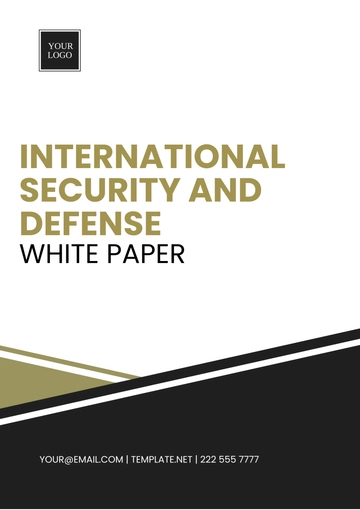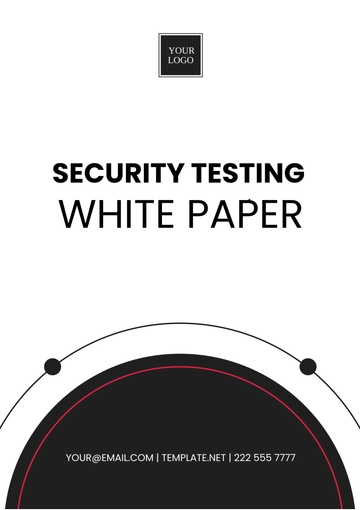Free International Security And Defense White Paper

____________________________________________________________________________________
Strategic Framework for National Security and Defense Policies
Prepared by: [Your Name]
For: [Your Company Name]
Date: [Date]
Department: [Your Department]
_____________________________________________________________________________________
I. Executive Summary

This white paper provides a comprehensive overview of the strategic framework essential for shaping the security and defense policies of [Your Company Name]. It outlines the key priorities and strategic objectives necessary to uphold national security and streamline decision-making and resource allocation processes effectively in the face of evolving global threats.
II. Introduction
The security challenges facing [Your Company Name] in the contemporary global environment require a robust and adaptive strategic framework. This document serves to articulate the vision and underpinning strategies that will guide [Your Company Name] in maintaining sovereignty and protecting its interests against diverse and dynamic threats, ensuring a proactive stance in the ever-changing security landscape.
III. Strategic Objectives
Define the national security and defense goals that align with the broader interests of [Your Company Name].
Identify key areas requiring enhanced capabilities and resource investment to address emerging threats effectively.
Establish measurable and achievable targets to evaluate progress and implementation efficiency, fostering accountability and adaptability in security initiatives.
IV. Policy Development
This section delineates the process of forming the policies that will support the strategic objectives detailed previously. It includes methodologies for:
Engagement with stakeholders, ensuring inclusivity and collaboration across government agencies, defense departments, and industry leaders.
Rigorous assessment of current capabilities and identification of gaps in resources and infrastructure, laying the groundwork for targeted improvements.
Implementation of a phased strategy for upgrading systems and processes, promoting agility and scalability in response to evolving security challenges.
V. Resource Allocation
Effective resource allocation is crucial for the success of national defense strategies. This section provides a comprehensive framework for prioritizing expenditure and optimizing budgetary outcomes, considering:
Comprehensive analysis of current financial resources and economic projections to inform strategic investment decisions.
Prioritization of critical areas of need while balancing optional enhancements to maximize impact and efficiency.
Long-term sustainability and impact assessment of investment choices, ensuring enduring resilience and adaptability in the face of future uncertainties.
VI. Implementation Roadmap
This section identifies specific actions, timelines, and responsible parties involved in the rollout of new policies and strategies, fostering accountability and clarity in execution:
Phase | Action Items | Timeline | Responsible Department |
|---|---|---|---|
1 | Initial assessment and stakeholder consultation | January 1, 2050 - February 25, 2050 | Department of Strategic Planning |
2 | Development of strategic objectives framework | March 1, 2050 - April 30, 2050 | Department of Defense Strategy |
3 | Policy formulation and approval | May 1, 2050 - June 30, 2050 | National Security Council |
VII. Monitoring and Evaluation
To ensure the effectiveness and flexibility of the security and defense policies, a comprehensive monitoring and evaluation mechanism is outlined, emphasizing continuous improvement and adaptability:
Regular reporting by [Department Name] on the status and outcomes of the implementation phases, facilitating real-time adjustments and course corrections.
Annual reviews to assess the impact and efficiency of the deployed strategies, promoting accountability and transparency in governance.
Flexibility to adjust strategies based on evolving threats and technological advancements, ensuring resilience and responsiveness in the face of emerging challenges.
VIII. Conclusion

This strategic framework sets forth the pillars essential to fortifying [Your Company Name]'s national security and defense postures, providing a roadmap for proactive and adaptive responses to evolving threats. By adhering to this framework, [Your Company Name] will effectively navigate the complexities of the modern security landscape, ensuring a resilient and robust defense capability that safeguards its citizens and interests.
IX. Appendices
Appendices may include additional data, charts, and references that support the content of this white paper. Be sure to accurately reference all third-party information and data used within your document.
X. References
Document all sources of information, data, and research used in the white paper. Adhere to a consistent citation style.
_____________________________________________________________________________________
- 100% Customizable, free editor
- Access 1 Million+ Templates, photo’s & graphics
- Download or share as a template
- Click and replace photos, graphics, text, backgrounds
- Resize, crop, AI write & more
- Access advanced editor
Introducing the International Security and Defense White Paper Template, exclusively crafted by Template.net. This editable and customizable masterpiece empowers you to articulate strategic insights effortlessly. Crafted with precision, it's editable in our Ai Editor Tool, ensuring seamless customization. Elevate your discourse with this essential tool, guiding your narrative towards informed decisions and unparalleled clarity.


















